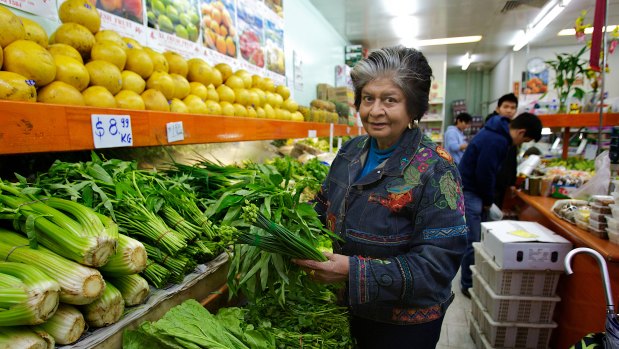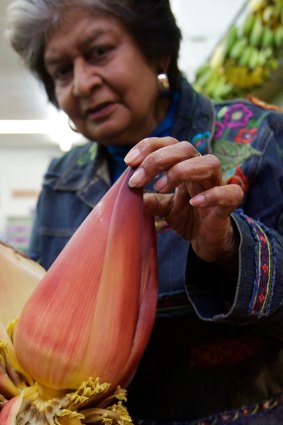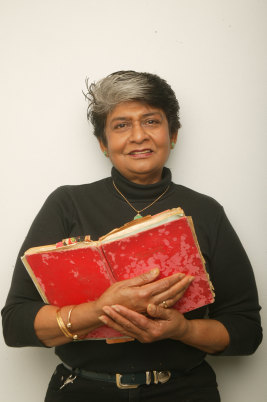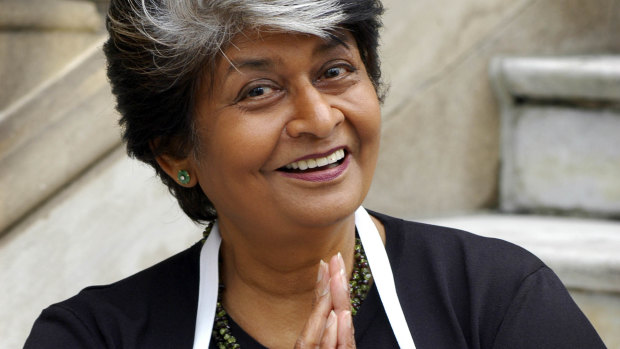By John Newton
For Carol Selva Rajah in 1981, Cabramatta was a culinary epiphany. Her students — she was teaching English to newly arrived Vietnamese migrants — took her to the market gardens where their parents were growing produce and then selling it on the street from large baskets.
"I was stunned to find Asian herbs I’d never seen in Australia," she wrote in her autobiography, Dining with Dragons, "lemongrass, Vietnamese mint, galangal, fresh coriander. Fresh lemongrass? In Cabramatta?"

Carol Selva Rajah found a Pandora's box of Asian groceries in Cabramatta in the early 1980s. Credit: Domino Postiglione
It was Cabramatta which kick-started her food career in Australia. After numerous car trips there, taking friends on eating trips and befriending shopkeepers and chefs, she invited then-editor of Australian Gourmet Traveller and the magazine’s feature editor, Meg Thomason, to come and taste Cabramatta for themselves in 1989.
That resulted in a story in the magazine headline A Day Trip to Asia in 1990. Cabramatta at the time had a bad reputation for drug-related crime, and Liverpool Council community relations manager Markus Lambert decided something had to be done.
“We thought if we could bring people out to look at the food, that would be a good way to go. They rang Carol, and she agreed to help," he said.

Carol Selva Rajah brought deep family heritage to her knowledge of ingredients.Credit: Domino Postiglione
“People would come on the tours with shopping trolleys and go home with them filled with local food. It was a big boost to the confidence level for the community and the shopkeepers. It was a ripple that turned into a wave.”
Those day trips eventually resulted in a Jaguar Award for Excellence in Gastronomic travel, and an award from the Asian Businessmen’s Association of Cabramatta for her contribution in creating a positive image for the suburb.
Singapore-born of a Sri Lankan-Malaysian family and able to speak four Asian languages — she was chosen to teach those Vietnamese migrants because one of those languages was Hokkien — Rajah was the epitome of Asian multiculturalism at a time when Australia was opening up to Asian cultures and cuisines.
Her background and skill in the kitchen transformed her into one of Australia's foremost experts on Asian cuisines and ingredients and the author of 13books from The Food of India to Makan-Lah, her definitive guide to the food of her beloved Malaysia.
Her first book, the Asian Microwave Cookbook, resulted in a television show in Malaysia which ran for five years. At the time, she was also teaching at St Mary’s Cathedral College in inner Sydney, and raising three children without her husband, Thambipilay Selvarajah (Selva). Each term break, she was flown to Kuala Lumpur to film episodes and live the life of a television personality before coming back to "a classroom full of sweaty teenagers".
Carol’s parents, Sara and George Arumugam, were Methodist teachers, her grandfather a Methodist minister. The family home in Klang, Malaysia (then Malaya) was a large house filled with aunts, uncles, nieces and nephews and the family of her Amah Kim, who she described as her "other mother".
In that house, they lived through the Japanese occupation and then the Emergency, a terrifying guerrilla war against both the British and the Malay Chinese by Communist Chinese. During the Emergency, the family hid a Chinese family, and Ah Peng, one of Amah Kim’s sons, in a secret room.
The one constant throughout Carol’s life was food. Her school tuck shop provided Nonya food (Chinese Malay fusion food): laksa sauces, Thai-style mee siam, mee goreng and rojak, Carol’s favourite — spiced star fruit, green mango and pineapple in a dark soy chill-studded sauce.
On a teenage trip to Sri Lanka with her parents, she discovered Sri Lankan flavours and the Dutch Burgher (Eurasian) food of her father’s wealthy relatives. While living in Johor Bahru, she learnt to cook the distinctly different regional dishes of Malaysia.

Carol Selva Rajah in her kitchen, 2004. Credit: Stephen Baccon
Sent to Methodist Ladies College in Perth, she arrived with a box of Chinese salted plums and a copy of Gone with the Wind. At the University of Malaya in Singapore, she met her future husband, Selva. But there were problems: he was a Jaffna Tamil Hindu, and objections were raised by her Methodist family. They solved that problem by eloping and marrying in Singapore in 1960.
After bearing three children, time spent in Malacca and Johor Bahru, a sojourn in Canada while Selva (a geneticist) gained his PhD, Carol arrived in Australia, taught briefly in Armadale and then jumped into the world of food in the deep end, taking over a cafe in Hornsby in 1979.
Inheriting a menu of hamburgers, chips, supermarket rolls ("the noble spring roll debased into a cylinder of armour-plate dough and sour cabbage") she gradually and successfully introduced tempura-battered fish, a spiced-down chicken curry and standard Sydney fried rice bulked with chopped lap cheong sausage.
Her daughter, Anushiya, recalls her grandmother coming to the cafe and reprimanding Carol: “I didn’t make sure you had an education so you could end up washing up other people’s plates.”
Exhausted by the physical strain of cafe work, Carol moved to Lae in Papua New Guinea, where Selva had been offered a job, only for Carol to have a serious medical problem and have to leave. Now she was back in Australia for good, with Selva joining her later.
The popularity of and the publicity engendered by the magazine article in 1990 encouraged Carol to set up a food business, Gourmet Asian Cuisine. This was financed by an unexpected bequest from an Australian friend. She was ready to start cooking and writing. Her Cabramatta trips also inspired another book, The Essential Guide to Buying and Using Authentic Asian Ingredients.
She began regular appearances cooking on television, with Trish Goddard and Bert Newton. In 1993, after travelling through south-east and western Asia, meeting chefs and visiting fish markets, she launched The Best of Asian Seafood Cookbook at the Sydney Seafood School. Then tragedy struck.
Selva was diagnosed with inoperable cancer and died in 1996, not before seeing his younger son married. Before the news of his illness, she had begun work on Makan-Lah! It took her a year to begin working on it again.
A year after Selva’s death, she was invited to New York to cook at the James Beard Foundation, a distinction she shared with only four other Australians, one being Tetsuya Wakuda. She cooked a Nonya feast using Australian produce accompanied by Australian wines.

Carol Selva Rajah: warm, generous, cultured and funny.
Many cookbooks and gastronomic events followed, including re-creating a Day Trip To Asia on a steam train to publicise the 2000 Olympics, cooking Malaysian food on the QE2 and being crowned the Chilli Queen at the Noosa Chilli Festival.
What is hard to convey is Carol's personality. She was warm, generous, cultured and very funny. She was also, as her dear friend, food writer Cherry Ripe, said, "one of the most vibrant, caring and inspirational individuals I have ever had the privilege to know".
In April, not long before she died, another friend, Lyndey Milan, came back from London and was quarantined. Lyndey recalls that “she went to so much trouble to make us a fish curry and all the trimmings and had it delivered it to the hotel”.
Carol is survived by her brother, Dr Abel Arumugam, her sons, Dr Soundara Rajah Selvarajah and Anand Selvarajah and daughter Anushiya Selvarajah.
John Newton
Carol Selva Rajah: 1938-2020